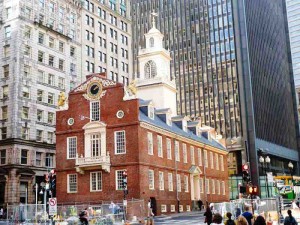Select your language to auto-translate:
Oldest Public Building in Boston (1713)
The Old State House was the site of the British government offices until they left after the Siege of Boston in 1776, and the state legislature until 1798. It was the site of many important Revolutionary-era events
https://www.revolutionaryspaces.org/old-state-house/ (617) 720-1713
The current building replaced the first Town House, built on this site between 1657-68, burned down in the Great Fire of 1711.
It is now the home of the Bostonian Society and houses an excellent museum and docent programs.
Admission. Combined admission to the Old South Meeting House and the Old State House.
Open Daily, 10-5. Check for holiday hours.
The Old State House is not considered wheelchair accessible
Public transportation: Orange or Blue lines to State Street. Alternative, Green line to Government Center, or Red line to Downtown Crossing.
The talks given by museum personnel are excellent and run 20-30 minutes – covering subjects such as the Boston Massacre and Old State House History. The museum has interesting collections. Plan at least an hour for your visit.
Background Information
Boston’s first official town hall, called the Town House, was started in 1657 and dedicated in 1658. It was enabled when Robert Keayne willed £300 for a Town House with stipulations not only to size and construction, but also that it would contain a marketplace, a library, and serve as the home for the Ancient and Honorable Artillery Company, of which he was the commander. Keayne’s bequest was doubled by over 100 “Townesmen,” enabling the Town House to be built.
The first Town House served for the next 53 years until it burned down in the Great Fire of 1711. Within two years, the current Old State House was built. This building was gutted by fire in 1747 and reconstructed over the next three years.
The Old State House was to serve as the location for British Government offices until the British left Boston in 1776. In addition to the meeting chamber of the Royal Governor, the Massachusetts Assembly and the Courts of Suffolk County and the Massachusetts Supreme Judicial Courts met here.
The Old State House was the site of many significant events leading up to the revolution, including James Otis’s impassioned argument against the Writs of Assistance in 1761. In 1770, the Boston Massacre took place just in front of the building.
Official proclamations were read from the balcony overlooking State Street (it was called King Street before the Revolution). On July 18, 1776, the Declaration of Independence was read from the balcony to a crowd of excited Bostonians. Soon after hearing the Declaration, the lion and unicorn, symbols of the British monarchy, were torn down. They were replaced during the building’s renovation in 1882.
After the Revolution, the Old State House continued to operate as the seat of Massachusetts government until the new State House was completed in 1798. The state then wanted to sell the building and share the money with the town. The town rejected the plan and instead purchased sole title.
The building was subsequently rented to a wide variety of businesses including cobblers, harness makers, and wine vendors. A bank tried to purchase it in 1822. For a period between 1830 and 1844 it became a Boston City Hall.
By the 1870’s it was dilapidated and an eyesore. The city of Chicago offered to buy it, tear it down and move it to Lake Michigan “for all America to revere.” Shamed by the proposal, in 1881 the Boston Antiquarian Club was formed, later incorporating as the Bostonian Society. The Society persuaded the city to save and restore the building.
Today, the Bostonian Society operates an excellent museum that features talks and tours. The museum displays artifacts from the Revolutionary period that include many of John Hancock’s personal possessions. It is a worthwhile stop.
























[…] Stop 9 – Old State House. The Old State House features excellent docent-given tours and talks that cover the building and Revolutionary events. The museum has some good displays and exhibits. Plan about an hour to visit and take a tour. Highly worthwhile. […]